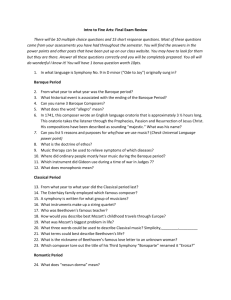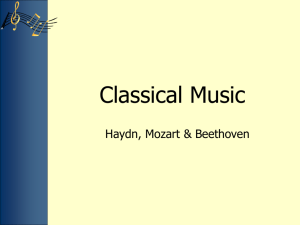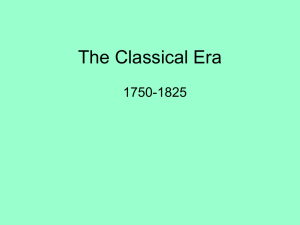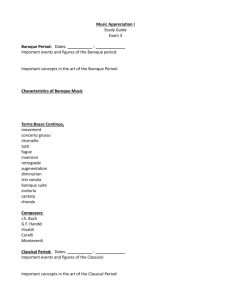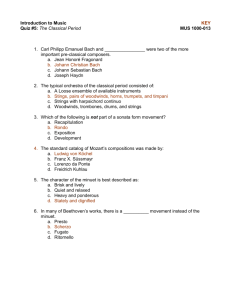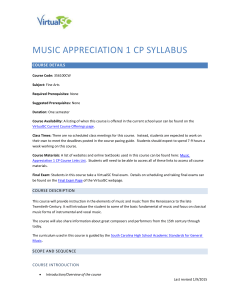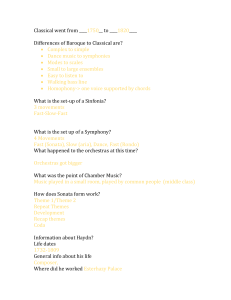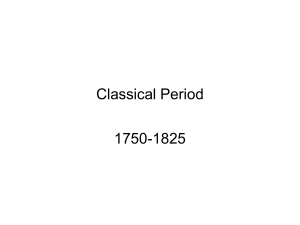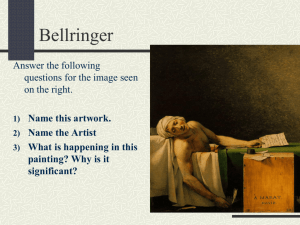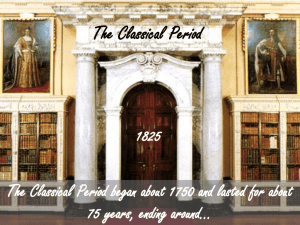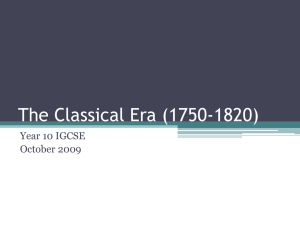The Classical Era
advertisement
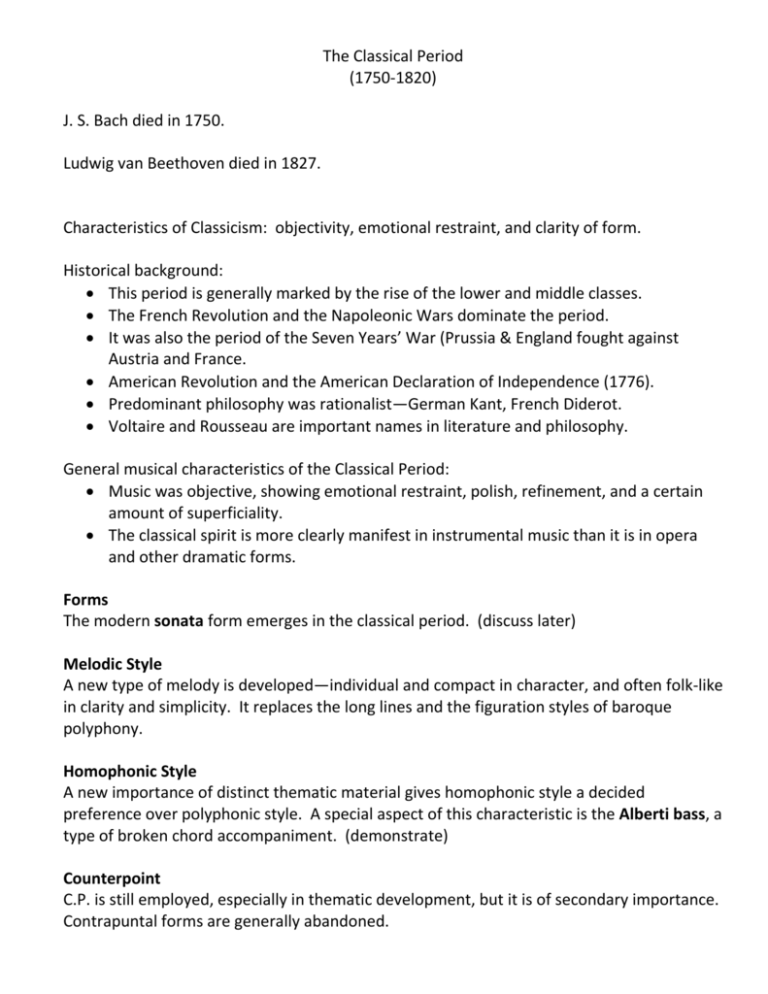
The Classical Period (1750-1820) J. S. Bach died in 1750. Ludwig van Beethoven died in 1827. Characteristics of Classicism: objectivity, emotional restraint, and clarity of form. Historical background: This period is generally marked by the rise of the lower and middle classes. The French Revolution and the Napoleonic Wars dominate the period. It was also the period of the Seven Years’ War (Prussia & England fought against Austria and France. American Revolution and the American Declaration of Independence (1776). Predominant philosophy was rationalist—German Kant, French Diderot. Voltaire and Rousseau are important names in literature and philosophy. General musical characteristics of the Classical Period: Music was objective, showing emotional restraint, polish, refinement, and a certain amount of superficiality. The classical spirit is more clearly manifest in instrumental music than it is in opera and other dramatic forms. Forms The modern sonata form emerges in the classical period. (discuss later) Melodic Style A new type of melody is developed—individual and compact in character, and often folk-like in clarity and simplicity. It replaces the long lines and the figuration styles of baroque polyphony. Homophonic Style A new importance of distinct thematic material gives homophonic style a decided preference over polyphonic style. A special aspect of this characteristic is the Alberti bass, a type of broken chord accompaniment. (demonstrate) Counterpoint C.P. is still employed, especially in thematic development, but it is of secondary importance. Contrapuntal forms are generally abandoned. Harmony Classical music generally shows a remarkable simplicity—far less harmonic complexity than in the works of J. S. Bach, for example. No significant harmonic development occurs until the time of Beethoven. Many passages in instrumental music consist solely of principal triads. Seventh chords are used sparingly, and ninth chords not at all. Phraseology On the whole, the phrases in classical music are shorter and more regular than those in the baroque. Orchestration The basis of modern orchestration was established during the classical period. Instrumental combinations became standardized. (Explain—John Williams, for example. Mine in college re soprano sax.) … That’s why no sax in the orchestra. Dynamics Considerable attention to the effects of dynamic contrast are shown in the works of the classical masters. It is especially true in regard to the crescendo and decrescendo, v. the terraced dynamics of the baroque. Advent of the PIANO In the second half of the 18th century, the piano began to make progress as a musical medium. Not until the 19th century, however, did it completely replace the older keyboard instruments (harpsichord, clavichord). Musical output There was an enormous increase in the production of all kinds of music in the Classical period. This was no doubt enhanced by the expansion of music publishing business. The Four Great Composers Christoph Willibald Gluck (1714-1787), noted for operas and for opera reform. Franz Joseph Haydn (1732-1809), who wrote over 100 symphonies, chamber music (83 string quartets), and oratorios, and who is credited with having established the basis of modern orchestration and sonata form. Wolfgang Amadeus Mozart (1756-1791), who was equally great in symphonic music, chamber music, and opera. Ludwig van Beethoven (1770-1827), who, in his great symphonies, chamber music, piano music, Mass, opera, and oratorio, represents the culmination of the classical styles and forms and the transition to 19th-century romanticism. Sonata Form (p. 160) Discuss components. LISTEN: CD 2 #23 Mozart Symphony No. 40 in G Minor (Watch pp. 164-165) Theme and Variations (p. 165) Discuss two types: continuous, sectional LISTEN: CD 2 #32 Haydn Surprise Symphony (Watch pp. 166-168) Minuet and Trio (p. 168) Often used as third movement in larger forms. ABA (final “A” a D.C. repeat) LISTEN: CD 2 #38 Mozart Eine kleine Nachtmusik Rondo (p. 170) ABACABA, other versions LISTEN: CD 2 #41 Beethoven String Quartet in C Minor Piano Concerto (p. 188) LISTEN: CD 3 #5 Mozart Piano Concerto No. 23 in A Major (Watch pp. 189-191) Symphony (p. 197) LISTEN: CD 2 #45 Beethoven Symphony No. 5 (Watch pp. 199-201)
